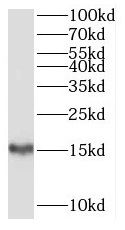Products
SH2D1B antibody
| Size | Price |
|---|---|
| 100µg | Inquiry |
- SPECIFICATIONS
- FIGURES
- CONDITIONS
- FAQS
- Product Name
- SH2D1B antibody
- Catalogue No.
- FNab07820
- Size
- 100μg
- Form
- liquid
- Purification
- Immunogen affinity purified
- Purity
- ≥95% as determined by SDS-PAGE
- Clonality
- polyclonal
- Isotype
- IgG
- Storage
- PBS with 0.02% sodium azide and 50% glycerol pH 7.3, -20℃ for 12 months(Avoid repeated freeze / thaw cycles.)
- Immunogen
- SH2 domain containing 1B
- Alternative Names
- SH2 domain-containing protein 1B|EWS/FLI1-activated transcript 2 (EAT-2)|SH2D1B|EAT2 antibody
- UniProt ID
- O14796
- Observed MW
- 15 kDa
- Tested Applications
- ELISA, WB, IHC
- Recommended dilution
- WB: 1:500-1:2000; IHC: 1:20-1:200
 Jurkat cells were subjected to SDS PAGE followed by western blot with FNab07820(SH2D1B antibody) at dilution of 1:800
Jurkat cells were subjected to SDS PAGE followed by western blot with FNab07820(SH2D1B antibody) at dilution of 1:800
 Immunohistochemistry of paraffin-embedded human kidney tissue slide using FNab07820(SH2D1B Antibody) at dilution of 1:200
Immunohistochemistry of paraffin-embedded human kidney tissue slide using FNab07820(SH2D1B Antibody) at dilution of 1:200
- Background
- Cytoplasmic adapter regulating receptors of the signaling lymphocytic activation molecule(SLAM) family such as CD84, SLAMF1, LY9 and CD244(PubMed:11689425). In SLAM signaling seems to cooperate with SH2D1A/SAP. Plays a role in regulation of effector functions of natural killer(NK) cells by controlling signal transduction through CD244/2B4 without effecting its tyrosine phosphorylation; downstream signaling involves PLCG1 and ERK activation(PubMed:24687958). Activation of SLAMF7-mediated NK cell function does not effect receptor tyrosine phosphorylation but distal signaling(By similarity). In the context of NK cell-mediated cytotoxicity does not enhance conjugate formation with target cells but stimulates polarization of the microtubule-organizing center and cytotoxic granules toward the NK cell synapse(PubMed:24687958). Negatively regulates CD40-induced cytokine procuction dendritic cells downstream of SLAM family receptors probably by inducing activation of the PI3K pathway to inhibit p38 MAPK and JNK activation(By similarity).
How many times can antibodies be recycled?
First, usually it's not suggested to recycle antibodies. After use, buffer system of antibodies has changed. The storage condition of recycled antibodies for different customers also varies. Thus, the performance efficiency of recycled antibodies can’t be guaranteed. Besides, FineTest ever conducted the antibody recycling assay. Assay results show recycling times of different antibodies also varies. Usually, higher antibody titer allows more repeated use. Customers can determine based on experimental requirements.
Notes: After incubation, we recycle rest antibodies to centrifuge tube and store at 4℃. High titer antibodies can be stored for a minimum of one week. Reuse about three times.
What are components of FineTest antibody buffer?
Components of FineTest antibody buffer are usually PBS with proclin300 or sodium azide, BSA, 50% glycerol. Common preservative is proclin300 or sodium azide, which is widely applied in the lab and industry.
How about the storage temperature and duration of FineTest antibodies?
Most antibodies are stored at -20℃. Directly-labeled flow cytometry antibodies should be stored at 2 - 8℃. The shelf life is one year. If after sales issues for purchased antibodies appear, return or replacement is available. Usually, antibodies can be still used after the one-year warranty. We can offer technical support services.
Is dilution required for FineTest antibodies? What’s the dilute solution?
Directly-labeled flow cytometry antibodies are ready-to-use without dilution. Other antibodies are usually concentrated. Follow the dilution ratio suggested in the manual. Dilute solution for different experiments also varies. Common antibody dilution buffers are acceptable(e.g. PBST, TBST, antibody blocking buffer).
How to retrieve antibodies for immunohistochemistry?
Common retrieval buffers: Tris-EDTA Buffer(pH 9.0); Citrate Buffer(pH 6.0)
Heat induced antibody retrieval:
Method 1: Water-bath heating: Put the beaker with retrieval buffer and slide in the boiling water bath. Keep the boiling state for 15min. Naturally cool to room temperature;
Method 2: Microwave retrieval: Put the beaker with retrieval buffer and slide in the microwave oven. Heat at high power for 5min, Switch OFF for 3min, Heat at medium power for 5min. Naturally cool to room temperature.
How to choose secondary antibodies?
(1) Secondary antibodies react with primary antibodies. Thus, secondary antibodies should be against host species of primary antibodies. E.g. If the primary antibody is derived from rabbit, the relevant secondary antibody should be against rabbit. E.g. goat anti rabbit or donkey anti rabbit.
(2) Choose secondary antibody conjugates according to the experimental type, e.g. ELISA, WB, IHC etc. Common enzyme conjugated secondary antibodies are labelled by HRP, AP etc. Fluorescin or dye labelled secondary antibodies are applied in immunofluorescence and flow cytometry(e.g. FITC, Cy3).
